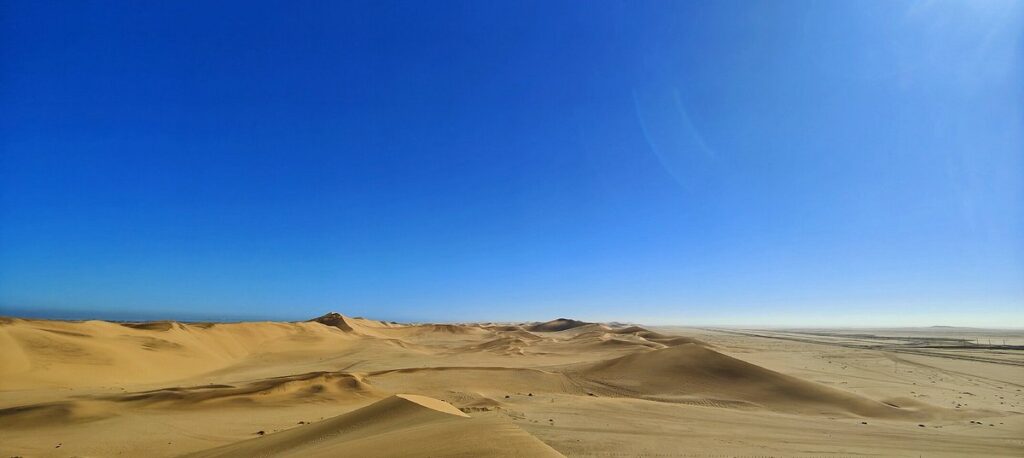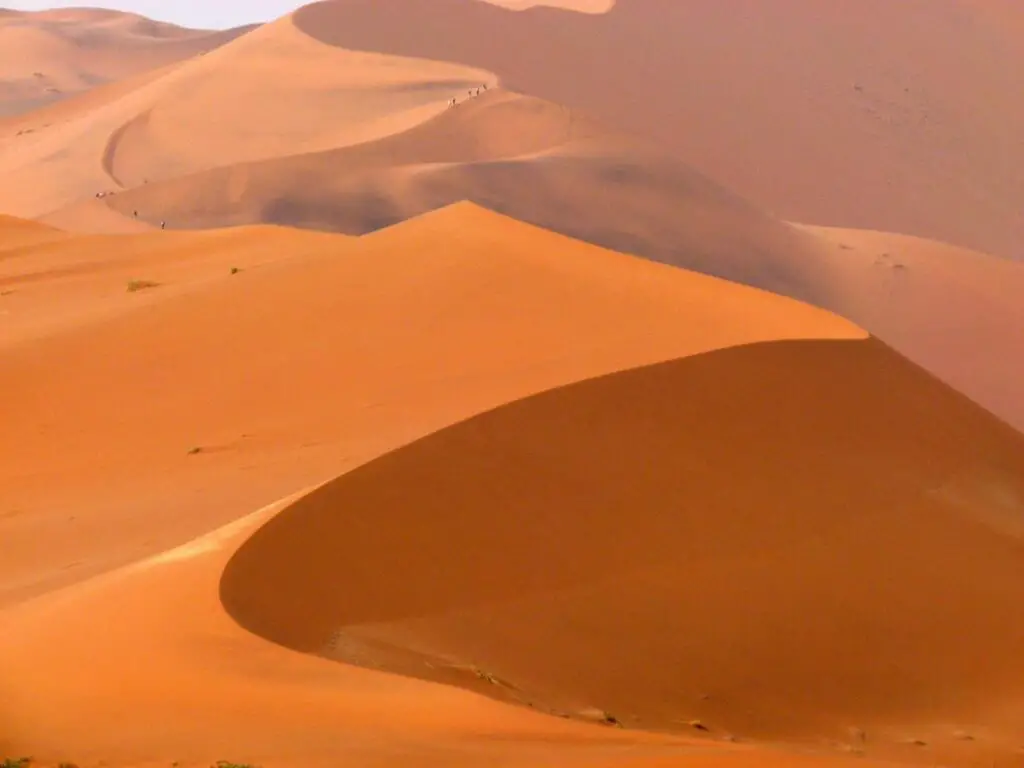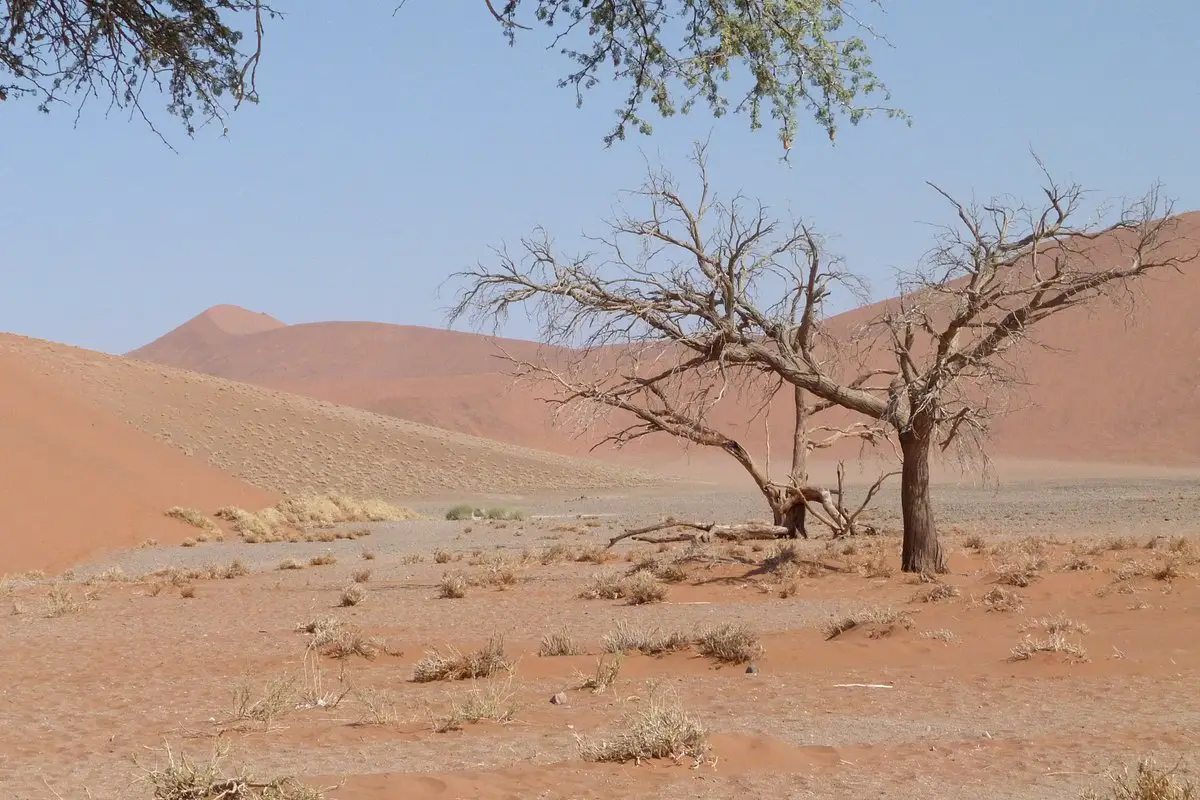The Namib Desert, spanning the coastal areas of Angola, Namibia, and South Africa, is a stunning landscape of towering sand dunes, arid gravel plains, and unique wildlife. This introduction would offer a brief description of the Namib Desert’s location, size, and key features, highlighting its global ecological and cultural significance.
Age of the Namib Desert
The Namib Desert, stretching over 2,000 kilometers along the Atlantic coasts of Angola, Namibia, and South Africa, is often cited as the oldest desert in the world. While it’s difficult to determine the exact age of a desert, the Namib is believed to have endured arid or semi-arid conditions for at least 55 to 80 million years, and possibly much longer.
Geological studies of the Namib’s sand dunes and the sedimentary formations beneath them provide some of the clearest evidence of the desert’s age. The unique sand sea (or erg) of the Namib, comprised largely of sand dunes, is the only coastal desert in the world to contain large dune fields. The composition and structure of these dunes suggest they have been shaped over tens of millions of years.
Unique Climate of the Namib Desert

The Namib Desert, despite its proximity to the equator, has a rather unique climate that is classified as an arid desert. What makes the Namib’s climate unique is largely due to its positioning between the cold Atlantic Ocean and the hotter African continental landmass, creating a fascinating climate with wide-ranging effects on the biodiversity of the region.
The Namib Desert, although hot during the day, can cool down significantly at night, with temperatures sometimes dropping below freezing. During summer, daytime temperatures can reach up to 45 degrees Celsius (113 degrees Fahrenheit), but with the setting of the sun, temperatures can plummet rapidly due to the lack of moisture in the air to trap the heat.
Winter temperatures can range from 20 degrees Celsius (68 degrees Fahrenheit) during the day to below freezing at night.
The Namib Desert is one of the driest places on Earth, with some areas receiving less than 10 mm of rainfall annually. The eastern part of the desert, away from the coast, is the driest area, with some parts seeing years pass without any rainfall. Even when it rains, the high evaporation rate often results in little effective precipitation.
The Namib Desert is also characterized by its consistent wind patterns. The persistent and strong winds play a role in shaping the desert’s iconic sand dunes and aid in the upwelling of the Benguela Current, which in turn, impacts the formation of the fog.
The interaction of these factors creates a climatic paradox – a desert that derives much of its moisture from fog rather than rain. This unique climate has led to the evolution of several unique plant and animal species that have adapted to rely on the fog as a primary water source.
Fog as a Life Source
Despite its arid conditions, the Namib Desert has a surprising source of water: coastal fog. The role of fog as a vital water source for desert life, and the adaptations of various species to capture this moisture, would be the focus of this section.
The cold Benguela Current in the Atlantic Ocean cools the air above it, and when this cool air collides with the warm desert air, it forms a dense fog. This fog rolls inland, sometimes as far as 50 kilometers (31 miles), blanketing the desert in moisture. It’s estimated that the desert experiences foggy conditions on more than 100 days per year.
Diverse Wildlife

From desert-adapted elephants and rhinos to small reptiles and insects, the Namib supports a wide range of fauna. This section would offer an overview of the desert’s wildlife and discuss the unique adaptations that allow these species to survive in this harsh environment.
Mammals: A striking example is the desert-adapted elephant. These elephants are not a separate species but have developed remarkable adaptations, such as larger feet for walking on sand and an ability to go for several days without water. Similarly, there are desert-adapted lions and black rhinos in the Namib, both of which have learned to survive in the arid environment by ranging widely in search of food and water.
Several small mammals have evolved to be nocturnal to escape the daytime heat. Examples include the golden mole, which ‘swims’ through the sand in search of insects, and the dune gerbil.
Reptiles and Amphibians: The Namib Desert is also home to various reptiles, including snakes like the horned adder and the sidewinding adder. There are also numerous lizard species, such as the web-footed gecko, which is adapted to move easily on loose sand and can absorb water through its skin from the morning fog.
A unique resident of the Namib is the desert chameleon, which adjusts its color not only for camouflage but also for temperature regulation – turning black to absorb heat in the cool mornings and a lighter color to reflect light during the intense heat of midday.
Amphibians seem out of place in a desert, but the barking gecko has adapted to burrow into the cooler, moist sand during the day, emerging at night to feed.
Birds: The Namib Desert supports a range of bird species. The region’s gravel plains are frequented by ostriches and birds of prey like the pygmy falcon, while the coastal areas and ephemeral rivers attract numerous migratory and wading birds. One of the most iconic birds of the Namib is the Rüppell’s korhaan, easily spotted due to its distinctive call.
Insects and Arachnids: The Namib hosts a diverse array of invertebrates, including the Namib desert beetle, which has gained fame for its fog-collecting abilities. Another remarkable species is the dancing white lady spider, which escapes predators by flipping onto its side and cartwheeling down sand dunes.
Unique Flora

Some plants in the Namib, like the endemic Welwitschia mirabilis, have evolved to capture and condense fog into a liquid that can be absorbed. The leaves of this plant are structured to channel the condensed fog water towards the root system.
Another plant, the dollar bush, has succulent leaves that can store water from the fog. Similarly, lichens found on the desert’s gravel plains absorb water directly from the frequent fogs. Here are more details on the plants that have adapted to the Namib desert climate.
Welwitschia Mirabilis: Perhaps the most famous plant species in the Namib Desert is the Welwitschia mirabilis. This unusual plant consists of two leaves, a stem base and roots. The two leaves are permanent and continue to grow throughout the plant’s life, which can extend for over 1,000 years. The leaves often become split and frayed into numerous strap-shaped sections by the desert wind. The plant is well adapted to the arid desert environment as it obtains most of its moisture from the coastal desert fog.
Nara Melon (Acanthosicyos horridus): The Nara melon is a leafless, spiny fruit plant endemic to the Namib Desert. The plant is well-adapted to desert life, with long taproots that reach deep into the sandy soil to access groundwater, and large, oil-rich seeds that provide a valuable food source for local wildlife.
Hoodia: The Hoodia genus includes several succulent plants native to the Namib Desert. Hoodia plants have a unique, cactus-like appearance and have evolved to store water in their thick stems to survive the desert heat.
Dollar Bush (Zygophyllum stapffii): This plant is a succulent shrub that has adapted to the desert conditions by developing small, thick leaves that store water. The leaves, when closed, resemble a silver dollar, hence the common name.
Nara Plant (Acanthosicyos horridus): This plant is a melon that has perfectly adapted to the desert conditions by not developing leaves, which could lose water. The !Nara plant’s fruits are a major food source for Topnaar people, a local community.
Camel Thorn Tree (Acacia erioloba): Named for its popularity as fodder among camels, this tree has a deep root system that allows it to reach underground water sources inaccessible to other plants. Its seeds provide food for various animals.
Lichens: In the coastal parts of the Namib Desert, one can find fields of lichens – complex life forms that arise from the symbiotic relationship between fungi and algae. There are about 120 different species of lichen in the Namib Desert, and they play a vital role in this harsh ecosystem by binding sand grains and contributing to soil formation.
These plant species are a testament to the resilience and adaptability of life, even in some of the world’s harshest conditions. Each has evolved distinct survival strategies that allow them to thrive in an environment where water is scarce, and the sun is relentless.
Sand Dunes of the Namib

The sand dunes of the Namib Desert are one of its most iconic and striking features. Spanning a vast swath of the landscape, these dunes rank among the tallest in the world and create a breathtaking, ever-changing spectacle.
The dunes of the Namib Desert are composed primarily of sand brought by the Orange River from the Drakensberg Mountains in South Africa. This sand is carried by ocean currents and then deposited onto the land by the wind.
Over thousands of years, these sand particles, shaped and shifted by the wind, have formed the Namib’s vast dune fields. The dunes continue to change and move over time, making the landscape of the Namib a dynamic and ever-changing one.
The Namib Desert features several types of dunes, including star dunes, transverse dunes, and longitudinal dunes. The most famous and abundant are the star dunes, which are pyramid-shaped and have several arms extending from a central point. These dunes are formed by winds coming from multiple directions.
Sossusvlei Dune Field: Located in the Namib-Naukluft National Park, the Sossusvlei dune field is one of the most photographed places in Sub-Saharan Africa. It is home to some of the highest dunes in the world, reaching up to 325 meters (1,066 ft). The dunes here are notable for their vibrant, reddish color, a result of iron oxide in the sand.
Dune 7: Dune 7 is believed to be the tallest sand dune in the world, with an estimated height of 383 meters (1,256 feet). It is named for its position as the seventh dune along the Tsauchab River. Climbing to the top of Dune 7 is a popular challenge for visitors to the Namib Desert.
The sand dunes of the Namib, in their stunning beauty and extreme conditions, underscore the desert’s reputation as a place of stark contrasts and surprising adaptability. Their ceaseless movement, driven by the winds, serve as a vivid reminder of the ever-changing nature of our planet.
The Skeleton Coast
The Skeleton Coast is a desolate and often foggy stretch of the Atlantic coast of northern Namibia and southern Angola. Its name comes from the numerous shipwrecks that have occurred here, as well as the skeletal remains of whales and seals hunted in the 19th and early 20th centuries.
This haunting landscape is one of the most inaccessible and inhospitable places on Earth, yet it is hauntingly beautiful and hosts a surprising array of wildlife.
The Skeleton Coast stretches for about 1,500 kilometers (930 miles), from the Kunene River on the Angola-Namibia border in the north to the Swakop River to the south. The area is characterized by dense coastal fogs, strong currents, and violent storms, which have led to numerous shipwrecks over the centuries. Inland, the coast is flanked by the Namib Desert’s sand dunes and gravel plains.
The Skeleton Coast has earned its ominous name from the many ships that have met their end here. The combination of dense fog, rocky and sandy shores, and strong ocean currents have proven fatal to countless vessels. The rusting remnants of these shipwrecks, some of which date back centuries, are scattered along the coastline, adding to the area’s eerie and desolate atmosphere.
Despite its harsh conditions, the Skeleton Coast is home to a diverse array of wildlife. It hosts one of the world’s largest colonies of Cape fur seals at Cape Cross. Other mammal species found along the coast include brown hyenas, jackals, and desert-adapted elephants and lions. The coastal and riverine habitats also support a variety of bird species, including flamingos, cormorants, and the endemic Damara tern.
Indigenous Cultures
The indigenous cultures of the Namib Desert are as fascinating and diverse as the landscape itself. Despite the harsh conditions, people have lived in this region for thousands of years, adapting to its unique challenges and developing rich cultures that reflect their close relationship with the environment. Here are two key indigenous cultures associated with the Namib Desert:
The Himba People: The Himba are semi-nomadic pastoralists who live in the Kunene Region, in the northern part of the Namib Desert and across the border in Angola. Known for their distinctive appearance, Himba women apply a red ochre paste, called otjize, to their skin and hair, a practice that is both aesthetic and functional, as the paste offers protection from the harsh desert sun.
The Himba people have a deep spiritual connection to their ancestors, whom they believe guide and protect them. Their economy is based on breeding cattle and goats, and wealth is determined by the number of animals one possesses. Despite encroaching modernization, many Himba continue to live traditionally, maintaining their cultural practices and knowledge.
The San People: Also known as Bushmen or Basarwa, the San people are considered to be the oldest inhabitants of southern Africa, with archaeological evidence suggesting their presence for over 20,000 years. They are renowned for their deep knowledge of the desert environment and wildlife, which they have used to survive as hunter-gatherers for millennia.
The San people have a rich oral tradition and are famous for their rock art, which depicts animals, people, and hunting scenes. The San also have a deep spiritual connection to the natural world, believing in a variety of nature spirits and supernatural beings.
Dark Sky Reserve
The NamibRand Nature Reserve in the Namib Desert is one of the largest private nature reserves in Africa. In 2012, it achieved another distinction: it was designated a Gold Tier Dark Sky Reserve by the International Dark-Sky Association (IDA). This makes it one of the best places in the world for stargazing, thanks to its low light pollution, clear skies, and minimal atmospheric pollution.
Dark Sky Reserves are areas recognized by the IDA for their exceptional or distinguished quality of starry nights and nocturnal environment. These areas are protected for scientific, natural, educational, cultural, and public enjoyment. The Gold Tier status is the highest level of award that the IDA bestows, representing areas that have the most pristine night skies.
NamibRand’s location in a remote part of southwestern Namibia, far from cities and towns, means that it has some of the darkest skies measured on Earth. This lack of light pollution allows for an incredible view of the stars, planets, and other celestial bodies.
The NamibRand Nature Reserve’s clear skies and minimal light pollution make it a paradise for astronomers and stargazers. On a clear night, visitors can see a myriad of stars, the Milky Way, and other celestial bodies with the naked eye. The clarity of the sky also allows for excellent viewing of meteor showers, planets, and other astronomical events.
The Dark Sky Reserve status has enhanced the reserve’s appeal for eco-tourism. The lodges in the reserve offer special programs for stargazing, including overnight experiences. Visitors can spend the night in specially designed open-air “star beds” to fully experience the incredible starry skies.
The NamibRand Dark Sky Reserve offers a rare chance to experience one of nature’s most spectacular displays. As one of the world’s premier destinations for stargazing, it provides a powerful reminder of our place in the universe and the importance of preserving natural darkness.
Offers A Range of Ecotourism Activities
Eco-tourism in the Namib Desert has grown significantly in recent years, driven by the region’s stunning natural beauty, unique biodiversity, and cultural heritage. The key principle behind eco-tourism is to promote sustainable travel that benefits local communities, conserves the environment, and educates visitors about the local ecosystem and culture.
The Namib Desert offers numerous opportunities for nature and wildlife viewing. From the iconic red sand dunes of Sossusvlei to the seal colonies of the Skeleton Coast and the diverse wildlife in the national parks, there’s plenty to captivate nature enthusiasts.
As mentioned earlier, the NamibRand Nature Reserve’s status as a Gold Tier Dark Sky Reserve makes it an ideal destination for stargazing. Eco-lodges in the reserve offer astronomy programs, and some even have their own observatories.
There are also opportunities to learn about the local indigenous cultures, such as the Himba and the San people. These tours can provide a fascinating insight into their traditional ways of life and their deep knowledge of the desert environment.
The vast, rugged landscapes of the Namib Desert are perfect for hiking, off-road driving, hot air ballooning, and even sandboarding down the massive dunes. However, these activities are carefully managed to minimize their impact on the environment.
Many eco-tourism operators in the Namib Desert actively contribute to conservation and research efforts. This might involve studying and protecting local wildlife, preserving the unique desert ecosystem, or working on projects to minimize the impact of tourism on the environment.
A number of lodges and campsites in the Namib Desert are committed to sustainability. They may use renewable energy sources, recycle water, reduce waste, and source food and other supplies locally. These establishments often provide jobs and other benefits for local communities, promoting sustainable development.
Through eco-tourism, visitors to the Namib Desert can have a memorable and rewarding travel experience while also contributing to the conservation of this unique and fragile environment. It’s an excellent way to explore one of the world’s most stunning landscapes while ensuring that it is preserved for future generations.


